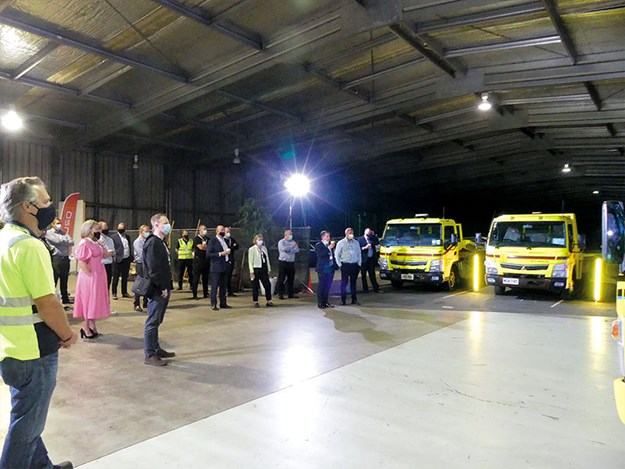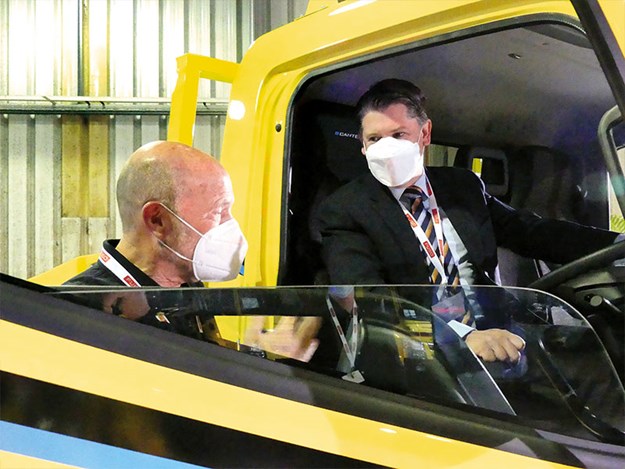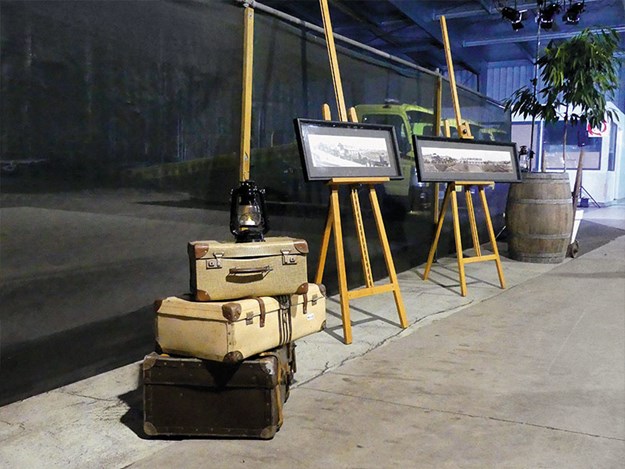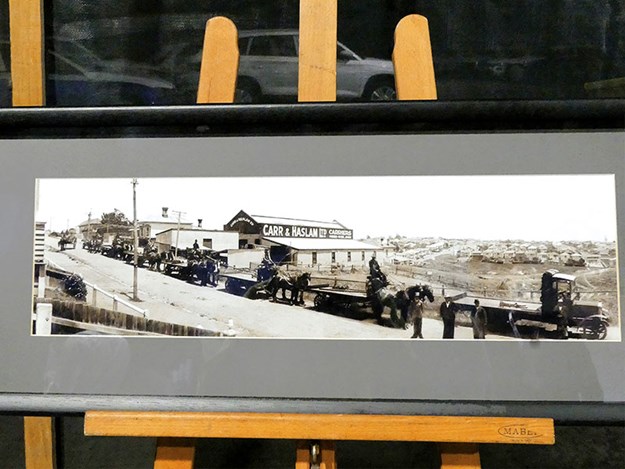Cover story: Fuso e-canter
Carr & Haslam’s first EV delivery by an EV truck
Throughout Carr and Haslam’s 100-year-plus involvement in transportation, the company has never been afraid to put its money where its mouth is when it comes to innovating the road transport industry, initially by introducing a motorised truck in 1922 when most of its competitors were still using horses and carts to make their deliveries.
Fast forward to 2022 and the company was at it again, only this time it was to call together a contingent of media and other interested parties to witness yet another first for New Zealand—the first delivery of a PEV (plug-in electric vehicle) by a PEV.
The theme of firsts
 |
|
Loading the second EV of the day, a Skoda Enyaq SUV
|
Keeping up with the theme of ‘firsts’, it was agreed by all present at the launch that the unbelievably early start of 5am (yes, you did read that correctly) was most certainly the earliest vehicle launch that even the longest-serving media person present could remember attending.
When Chris Carr was asked why he’d pulled people out of bed so early, he said that 5am was the only spot transport minister Hon Michael Wood had free on that day, which all goes to prove that there are government ministers who do actually care about what the movers and shakers of this country are up to.
In order to ensure Minister Wood could leave for his next appointment at 5:30am, Chris, in his typical down-to-earth manner, gave a brief history of the company’s century-plus history and pointed to a framed promotional photo sitting on an easel.
The photo was taken in 1922 outside George Carr and Wallace Haslam’s original depot in Dickens Steet, Grey Lynn and showed a team of horses and carts following the company’s latest acquisition, a petrol-powered truck.
Chris cited a couple of uncanny parallels between two momentous occasions in the company’s history, one being that the shift from horse-drawn to motorised transport 100 years ago was celebrated with promotional photos and the current 2022 move to an EV with its associated promotional pics and that both occurred following epidemics (1918 Spanish flu and 2019 COVID-19). Now, how coincidental is that?
Tough decisions
 |
|
The early morning trip through the Waterview tunnel
|
After thanking the invited guests for their commitment to the early start, Chris said that his grandpop would’ve been proud to be a part of this latest venture into the future of transportation, as the boldness of the current venture wasn’t too far removed from the "tough decision" his grandfather must have made to motorise his fleet way back in the first quarter of the 20th Century.
For the benefit of the 21st-Century motorist reading this article, New Zealand roads in the early part of the 20th Century weren’t all like the smooth tar-sealed roads we drive on today.
So, the decision made by the company founders to move from horse and cart to petrol power (or ‘benzine’ as it was known back in the day) would have presented its own set of problems, not the least of which would’ve been getting stuck in mud after a downpour and having to suffer the indignity of being pulled out by one of the company’s trusty, soon-to-be redundant horses.
Chris added that in 1922, there were immediate productivity gains to be had, as "pouring a few gallons of petrol into the tank of a truck was a lot easier than shoving a bale of hay at a horse", not to mention that a truck could cover greater distances in a shorter space of time on the majority of occasions.
The rationale behind the decision made back in 2021 to enter an E-Canter into his fleet of 70-or-so diesel-powered vehicle transporters, he says, would’ve been quite different from the research carried out by his forebears, as an electric-powered truck can’t deliver a car any quicker than one of its diesel-powered counterparts.
EECA support
 |
|
From left: Chris Carr, Kathy Schluter, and Hon Michael Wood
|
To this end, Chris plainly stated that if it wasn’t for EECA’s (Energy Efficiency & Conservation Authority) support, an electric truck simply wouldn’t be a viable proposition at this point in time. While admitting that at this early stage of the introduction of EVs into commercial fleets, it will be harder to turn a profit due to the purchase price of electric trucks being approximately twice the price of a diesel vehicle, even when you take the EECA subsidy and the freeze on RUCs for EVs until 2025 into account, Chris says someone had to be first. Also, as take-up of the use of EVs to transport product increases, prices of the vehicles and the infrastructure that supports them will naturally come down, he says.
With an ever-increasing number of electric cars entering the New Zealand market, many of which take their first trip on the back of a Carr and Haslam transporter, Chris commented that it made a lot of sense for his company to lead the charge (so to speak) in bringing about a completely new way of transporting cars and vans from point A to point B.
The Fuso connection
 |
|
Guest arriving accompanied by two Carr and Haslam diesel Canters
|
The latest step towards decarbonisation of the Carr and Haslam fleet isn’t a first for the company either, as four years ago, Chris and his management team made the call to only purchase trucks that were Euro 6 compliant.
The brand of truck they chose to fulfil this requirement were Fuso, a decision Chris says he’s pleased they made.
Kathy Schluter, group manager sales and customer experience at Fuso New Zealand, delivered a short presentation, speaking of her company’s long-standing association with Carr and Haslam, saying that the association was one of "friendship and partnership".
She commented on a government requirement that states that by 2030, some 30% of all new medium to heavy trucks sales are required to be zero-emission, and without the leaders in the industry providing the pathway, building the firsts, and then sharing their learnings, it would be an impossible feat.
Kathy also spoke of the exponential transformation the transport industry is currently experiencing.
"Our mechanics are now technicians that require diagnostic tools. Our trucks even from the Canter—the leading model of truck sales in New Zealand—to our Shoguns have fully integrated safety features where a driver has technology in his cab that will stop [a vehicle] faster than their mind can process the situation."
Kathy closed by passing her congratulations to Carr and Haslam: "The Fuso team will enjoy this ride with you."
Transport minister Michael Wood also congratulated Carr and Haslam for their foresight in spearheading the transition from fossil-fuelled vehicles to EVs and took great delight in cutting the blue bow on the truck’s windscreen, jokingly saying, "I always like cutting-through blue ribbons."
Sophie Song, marketing manager at Fuso New Zealand paid tribute to Carr and Haslam’s early days with a simple but effective touch of ambience to the early-morning start with a display that featured the previously mentioned 1922 promotional photo, along with other time-appropriate memorabilia—a clever piece of creativity indeed.
Time to hit the road
 |
|
Chris Carr, with transport minister Wood in the driver’s seat
|
By now it was still only 6am, with many of the attendees having been up and about since 3am or earlier, so it was time to snatch a quick coffee and a bun from the coffee cart that had been generously provided, while we all watched an Audi e-tron GT being loaded onto the eCanter, in preparation for the first delivery of an EV by an EV on New Zealand roads and more than likely anywhere in the Southern Hemisphere.
It’s fair to say that there was nothing unusual about the method of loading and unloading a car from the eCanter, as everything behind the cab is the same as a conventional truck; in fact, the only feature that distinguishes an eCanter from the rest of the Carr and Haslam fleet is the blue stripe around the cab, which is a departure from their normal brown striping.
Having safely unloaded the Audi e-tron GT at Giltrap Audi’s showroom in Great North Road, the next pick-up was yet another first for New Zealand, a Škoda Enyaq electric SUV that was to be taken back to the Carr and Haslam depot in Penrose.
Stress-free day at the office
 |
|
A subtle touch of nostalgia courtesy of Sophie Song, marketing manager at Fuso New Zealand
|
DOW, along with other media personnel, took turns to have a short ride-along and talk to the eCanter’s dedicated driver of the day, Dylan Gerin, who was assisted with loading and securing on the day by his immediate boss Alex Thompson, general manager of logistics, and co-worker Jason Howarth who were also on hand to ensure the safety of the photographers and other media folk.
Dylan says he was impressed with the immediate response the eCanter had when his foot went on the throttle and that the quietness of the vehicle made for a relatively stress-free day at the ‘office’.
He did say, however, that as with any piece of new technology, there were extra considerations that had to be taken into account when planning his day’s work, items such as making sure the truck was plugged into the charger as much as possible when cars were being loaded and unloaded back at the depot.
EV sceptics’ concerns addressed
 |
|
A promotional shot from yesteryear, 1922 style
|
While many of the early questions surrounding the viability of electric vehicles (particularly the commercial variety) are gradually being consigned to the history books, genuine concerns are still floating around as to our country’s electricity suppliers’ ability to provide enough power to charge the influx of EVs currently (no pun intended) entering the market.
To address this concern, we spoke directly to Andrew Renton, Transpower NZ Limited’s senior principal engineer.
Andrew says Transpower has a lot of history to draw upon when it comes to planning for and dealing with increasing demands on the national grid.
A classic example he says dates back to the 1950–1980s when there was a marked increase in the demand for power as households and business machines and appliances rapidly became electrified.
He went on to say that unlike the 1950–70s when the answer to providing extra power meant building more large hydropower dams—a process that took many years to complete, even when more than 35 power stations were built between the 1960s and 1980s to meet the then growing demand—today, however, there are many more electricity supply options than large hydro projects that range from grid scale, wind and solar farms to distributed solar on consumers premises that can be up and running in much shorter time frames.
There are also many more load management and efficiency improvements, including various Distributed Energy Resources (DER), such as batteries or demand response programmes.
The pace of the transition is also important. Although all fossil-fuelled vehicles represent a large amount of energy use, the fleet transition will occur over several years. This gives time for central generation to be built or end consumers to contribute their own DER solutions such as rooftop solar or batteries.
When speaking of the comparatively short distances an electric vehicle can currently travel on a full charge, Andrew says the next generation of new battery technology that doesn’t use rare earth or precious metals is starting to be rolled out.
Examples are the new silicon anode or lithium sulphur cells that are just going into wide-scale manufacture. These second-generation batteries provide for energy storage that’s half the weight and two thirds the volume of current models. This continued development when combined will enable a vehicle to travel twice as far and carry more revenue-generating payload.
He did say, however, that at this point in time, they’re more expensive to produce, so it may be some time before we get to see them readily available.
It’s important to remember the pace of change in 10 years. We have gone from Mitsubishi’s small i-Mev city car that cost $85k and could only travel 85km to Tesla 3, which goes 300–370km for $68k.
As Andrew correctly points out in the previous electric car examples, the pace of change he describes has ramped up to a point now where the Fuso eCanter, a truck with a gross laden weight of almost 7.5 tonnes can now travel up to 150km on a full charge. The tide of change is definitely on the rise.
For more information, visit fuso.co.nz/ecanter.
Find new and used trucks for sale in NZ
Keep up to date in the industry by signing up to Deals on Wheels' free newsletter or liking us on Facebook.











.jpg)
.jpg)
-(1).jpg)

_edited-2-(1).jpg)

